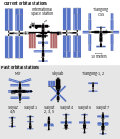Amateur Radio on the International Space Station

Amateur-satellite service Amateur Radio on the International Space Station (ARISS) - operating in the Amateur-satellite service - is a project sponsored by various entities and carried out by astronauts and cosmonauts on the International Space Station who also have an amateur radio license. The program was previously called SAREX, the Space Amateur Radio Experiment, and before that the Shuttle Amateur Radio Experiment. In 2011, Kenwood Electronics launched an advertising campaign capitalizing on the fact that their TM-D700A transceiver is currently in use on the ISS.[1]
Amateur radio operators all over the world are able to speak directly to astronauts/cosmonauts via their handheld, mobile, or home radio stations. Low power radios and small antennas can be used to establish communications. It is also possible to send digital data to the space station via laptop computers hooked up to the same radio and antenna, similar to an email communication, except that it uses radio frequencies instead of telephone or cable connections.
The space station occupants work a standard work day and have breaks in the evening and during meals. While on break, some of them will spend some time communicating with "earthlings" via amateur radio.
Interoperable Radio System (IORS)
Interoperable Radio System (IORS) is the foundation element of the ARISS next-generation radio system on ISS. A total of 4 flight units and 10 total units are being built by the ARISS hardware team. This first IORS radio will be flown to ISS on SpaceX CRS-20 and installed in the Columbus module.
A second flight unit is expected to be launched on a later 2020 cargo flight for installation in the Russian Service module.[2]
The IORS will include a higher power radio, an enhanced voice repeater, updated digital packet radio (APRS) capabilities and slow scan television (SSTV) capabilities for both the US and Russian segments. The IORS consists of a special, modified JVCKenwood D710GA transceiver, an AMSAT-developed multi voltage power supply and interconnecting cables.
Future upgrades and enhancements to the next generation system are in various stages of design & development. These include a repaired Ham Video system (currently planned for launch in mid-to-late 2020), L-band (uplink) repeater, ground command operations capability, LimeSDR signal reception, a microwave “Ham Communicator” and Lunar Gateway prototype experiment.
Notes
- ^ Social Activities - Amateur radios are loved even in space
- ^ "First Element of ARISS Next Generation Radio System Readied for Launch on SpaceX-20". ARISS. Retrieved 17 February 2020.




